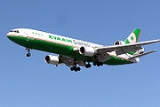
McDonnell Douglas MD-11
Overview
Trijet
A Trijet is an aircraft powered by three jet engines. Early twin-jet designs were limited by the FAA's "60-minute rule", whereby the flight path of twin-engined jetliners was restricted to within 60 minutes' flying time from a suitable airport, in case of engine failure. In 1964 this rule was...
medium- to long-range
Range (aircraft)
The maximal total range is the distance an aircraft can fly between takeoff and landing, as limited by fuel capacity in powered aircraft, or cross-country speed and environmental conditions in unpowered aircraft....
widebody
Wide-body aircraft
A wide-body aircraft is a large airliner with two passenger aisles, also known as a widebody aircraft or twin-aisle aircraft. The typical fuselage diameter is . In the typical wide-body economy cabin, passengers are seated seven to ten abreast, allowing a total capacity of 200 to 850 passengers...
jet airliner
Jet airliner
A jet airliner is an airliner that is powered by jet engines. This term is sometimes contracted to jetliner or jet.In contrast to today's relatively fuel-efficient, turbofan-powered air travel, first generation jet airliner travel was noisy and fuel inefficient...
, manufactured by McDonnell Douglas
McDonnell Douglas
McDonnell Douglas was a major American aerospace manufacturer and defense contractor, producing a number of famous commercial and military aircraft. It formed from a merger of McDonnell Aircraft and Douglas Aircraft in 1967. McDonnell Douglas was based at Lambert-St. Louis International Airport...
and, later, by Boeing Commercial Airplanes
Boeing Commercial Airplanes
Boeing Commercial Airplanes designs, assembles, markets and sells large commercial jet aircraft and provides product-related maintenance and training to customers worldwide...
. Based on the DC-10
McDonnell Douglas DC-10
The McDonnell Douglas DC-10 is a three-engine widebody jet airliner manufactured by McDonnell Douglas. The DC-10 has range for medium- to long-haul flights, capable of carrying a maximum 380 passengers. Its most distinguishing feature is the two turbofan engines mounted on underwing pylons and a...
, it features a stretched fuselage
Fuselage
The fuselage is an aircraft's main body section that holds crew and passengers or cargo. In single-engine aircraft it will usually contain an engine, although in some amphibious aircraft the single engine is mounted on a pylon attached to the fuselage which in turn is used as a floating hull...
, increased wingspan
Wingspan
The wingspan of an airplane or a bird, is the distance from one wingtip to the other wingtip. For example, the Boeing 777 has a wingspan of about ; and a Wandering Albatross caught in 1965 had a wingspan of , the official record for a living bird.The term wingspan, more technically extent, is...
with winglets, refined airfoil
Airfoil
An airfoil or aerofoil is the shape of a wing or blade or sail as seen in cross-section....
s on the wing and smaller tailplane
Tailplane
A tailplane, also known as horizontal stabilizer , is a small lifting surface located on the tail behind the main lifting surfaces of a fixed-wing aircraft as well as other non-fixed wing aircraft such as helicopters and gyroplanes...
, new engines and increased use of composite material
Composite material
Composite materials, often shortened to composites or called composition materials, are engineered or naturally occurring materials made from two or more constituent materials with significantly different physical or chemical properties which remain separate and distinct at the macroscopic or...
s. Two of its engines are mounted on underwing pylons and a third engine at the base of the vertical stabilizer
Vertical stabilizer
The vertical stabilizers, vertical stabilisers, or fins, of aircraft, missiles or bombs are typically found on the aft end of the fuselage or body, and are intended to reduce aerodynamic side slip. It is analogical to a skeg on boats and ships.On aircraft, vertical stabilizers generally point upwards...
. It also features an all-digital glass cockpit
Glass cockpit
A glass cockpit is an aircraft cockpit that features electronic instrument displays, typically large LCD screens, as opposed to the traditional style of analog dials and gauges...
that decreases the flight deck crew from the three required on the DC-10 to two by eliminating the necessity for a flight engineer
Flight engineer
Flight engineers work in three types of aircraft: fixed-wing , rotary wing , and space flight .As airplanes became even larger requiring more engines and complex systems to operate, the workload on the two pilots became excessive during certain critical parts of the flight regime, notably takeoffs...
.
Although the MD-11 program was launched in 1986, McDonnell Douglas
McDonnell Douglas
McDonnell Douglas was a major American aerospace manufacturer and defense contractor, producing a number of famous commercial and military aircraft. It formed from a merger of McDonnell Aircraft and Douglas Aircraft in 1967. McDonnell Douglas was based at Lambert-St. Louis International Airport...
started to search for a DC-10 derivative as early as 1976.
Unanswered Questions

